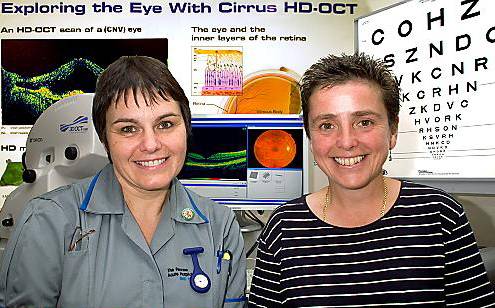Sight condition seen in 48 hours
Reporter: Marina Berry
Date published: 04 September 2009

Lynn Ford (left) and Dr Karen Goodall . . . excited about the new service
THE fight against a common condition which can cause severe sight loss has been boosted by a pioneering service at the Royal Oldham Hospital.
A new one-stop shop based in the hospital’s eye clinic, will assess and treat within 48 hours around 40 people each week with suspected wet age-related macular degeneration.
The condition, which mainly affects older people, can develop quickly, and early treatment is vital to stop it in its tracks.
Without treatment, it can destroy the sharp, central vision needed for common everyday tasks such as reading and driving.
Previously, patients faced a wait of several weeks for an appointment with an ophthalmologist, but are now seen within 48 hours of being referred from their GP or optician.
Age-related macular degeneration (AMD) is progressive and affects one in 10 of the UK population.
There are two types, wet and dry.
The wet form affects around 10 per cent of people who get AMD. It causes new blood vessels to grow behind the retina, resulting in bleeding and scarring which can lead to a lack of central vision and sight loss.
Consultant ophthalmologist Dr Karen Goodall, head of the new service, explained that patients are scanned to detect abnormalities at the back of the eye.
If further tests are needed, a small amount of dye is injected into the patient’s arm, and photographs taken as the dye passes through the blood vessels at the back of the eye.
Treatment starts the same day, and involves injecting a drug to seal weakened vessels within the eye to prevent the build-up of fluid and cloudy vision, which cuts the incidence of retinal haemorrhage and swelling.
Treatment takes place in a sterile “clean room,” similar to a hospital theatre, and usually only found in specialist eye hospitals.
A further two injections are given one month apart, and the eyesight of 90 per cent of patients is expected to stabilise.
Lynn Ford, an ADM practitioner, said the facilities had revolutionised treatment, and give-back the independence to older people which may have been lost through lack of sight.
“We keep them on a follow-up review programme which brings them back into clinic every four to six weeks.”
Most Viewed News Stories
- 1Milan Bar in Lees and The Bank at Delph close doors with immediate effect
- 2Latics announce retained list
- 3Punch perfect Kyle is Oldham's latest national boxing champ
- 4Attack on shop worker filmed and posted on Snapchat results in jail sentence for Oldham man
- 5Second-hand music, books and media shop opens in Mossley




